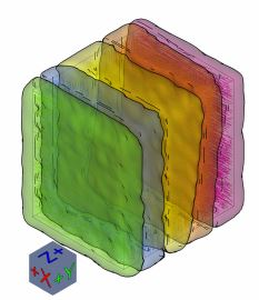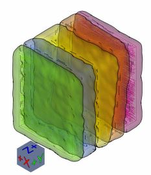Information
- Publication Type: PhD-Thesis
- Workgroup(s)/Project(s):
- Date: November 2019
- TU Wien Library:
- Second Supervisor: Christoph Heinzl
- Open Access: yes
- 1st Reviewer: Rüdiger Westermann
- 2nd Reviewer: Gerik Scheuermann
- Rigorosum: 5. December 2019
- First Supervisor: Eduard Gröller
Abstract
Advanced composites have excellent mechanical properties at low weight and can be realized as complex components that can be manufactured quickly and cost-effectively. Due to these outstanding characteristics, these materials are used in many di˙erent areas of industry, such as aviation and automotive. Industrial 3D X-ray computed tomography (XCT) is used as a non-destructive testing (NDT) method to inspect the quality of components and to develop new advanced composite materials. XCT has the ability to determine the inner and outer geometries of a specimen non-destructively. For example, interesting features in fiber-reinforced polymers (FRPs) such as fibers, pores, and higher-density inclusions can be detected. The high resolutions of modern XCT devices generate large volume datasets, which reveal very fine structures. However, this high information content makes the exploration and analysis of the datasets with conventional methods very diÿcult and time-consuming. In this doctoral thesis, typical NDT application scenarios of advanced composites using XCT are addressed and visual analysis methods and visualization techniques are designed to provide material experts with tools to improve their workflow and to eÿciently analyze the XCT data, so that domain-specific questions can be answered easily and quickly. This work describes a novel visualization system for the interactive exploration and detailed analysis of FRPs, a tool for the visual analysis and evaluation of segmentation filters to accurately determine porosity in FRPs, and a more general system for the visual comparison of interesting features in an ensemble of XCT datasets are presented. The results of the individual visualization systems are presented using real-world and simulated XCT data. The proposed visual analysis methods support the experts in their workflows by enabling improved data analysis processes that are simple, fast, and well-founded, and provide new insights into material characterization with XCT.Additional Files and Images
Weblinks
BibTeX
@phdthesis{Weissenboeck_2019_PhD,
title = "Visual Analysis of Methods for Processing 3D X-ray Computed
Tomography Data of Advanced Composites",
author = "Johannes Weissenb\"{o}ck",
year = "2019",
abstract = "Advanced composites have excellent mechanical properties at
low weight and can be realized as complex components that
can be manufactured quickly and cost-effectively. Due to
these outstanding characteristics, these materials are used
in many di˙erent areas of industry, such as aviation and
automotive. Industrial 3D X-ray computed tomography (XCT) is
used as a non-destructive testing (NDT) method to inspect
the quality of components and to develop new advanced
composite materials. XCT has the ability to determine the
inner and outer geometries of a specimen non-destructively.
For example, interesting features in fiber-reinforced
polymers (FRPs) such as fibers, pores, and higher-density
inclusions can be detected. The high resolutions of modern
XCT devices generate large volume datasets, which reveal
very fine structures. However, this high information content
makes the exploration and analysis of the datasets with
conventional methods very diÿcult and time-consuming. In
this doctoral thesis, typical NDT application scenarios of
advanced composites using XCT are addressed and visual
analysis methods and visualization techniques are designed
to provide material experts with tools to improve their
workflow and to eÿciently analyze the XCT data, so that
domain-specific questions can be answered easily and
quickly. This work describes a novel visualization system
for the interactive exploration and detailed analysis of
FRPs, a tool for the visual analysis and evaluation of
segmentation filters to accurately determine porosity in
FRPs, and a more general system for the visual comparison of
interesting features in an ensemble of XCT datasets are
presented. The results of the individual visualization
systems are presented using real-world and simulated XCT
data. The proposed visual analysis methods support the
experts in their workflows by enabling improved data
analysis processes that are simple, fast, and well-founded,
and provide new insights into material characterization with
XCT.",
month = nov,
address = "Favoritenstrasse 9-11/E193-02, A-1040 Vienna, Austria",
school = "Research Unit of Computer Graphics, Institute of Visual
Computing and Human-Centered Technology, Faculty of
Informatics, TU Wien ",
URL = "https://www.cg.tuwien.ac.at/research/publications/2019/Weissenboeck_2019_PhD/",
}


 image
image PhD Thesis
PhD Thesis
